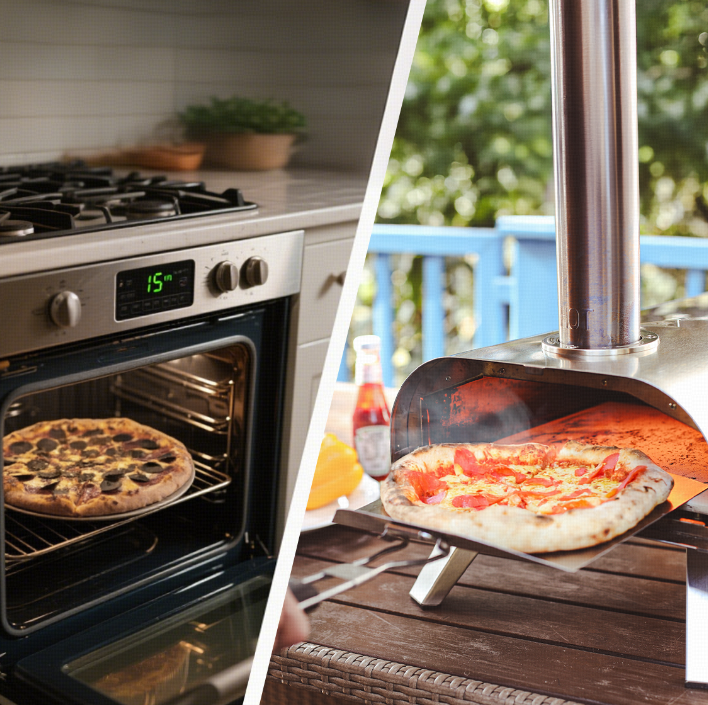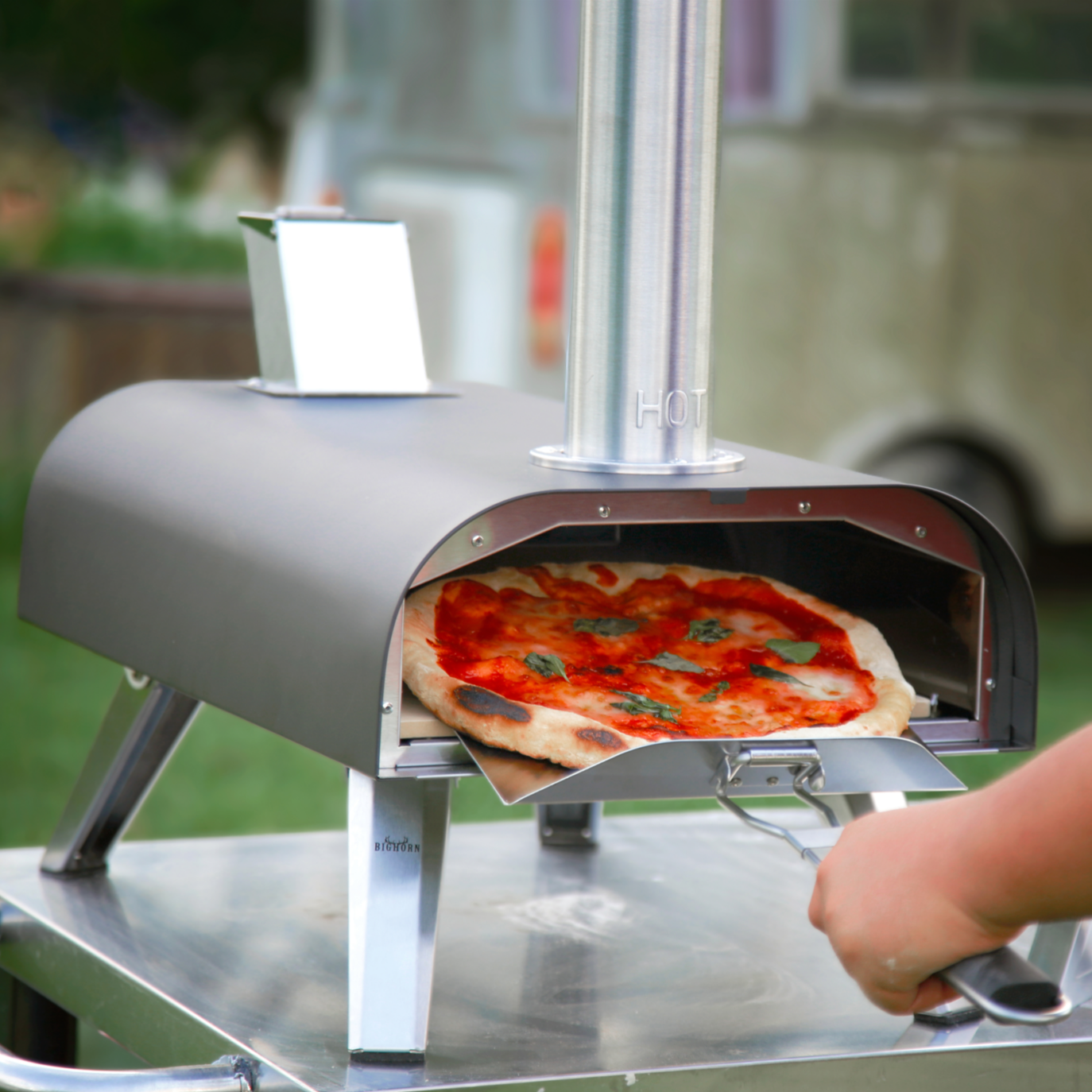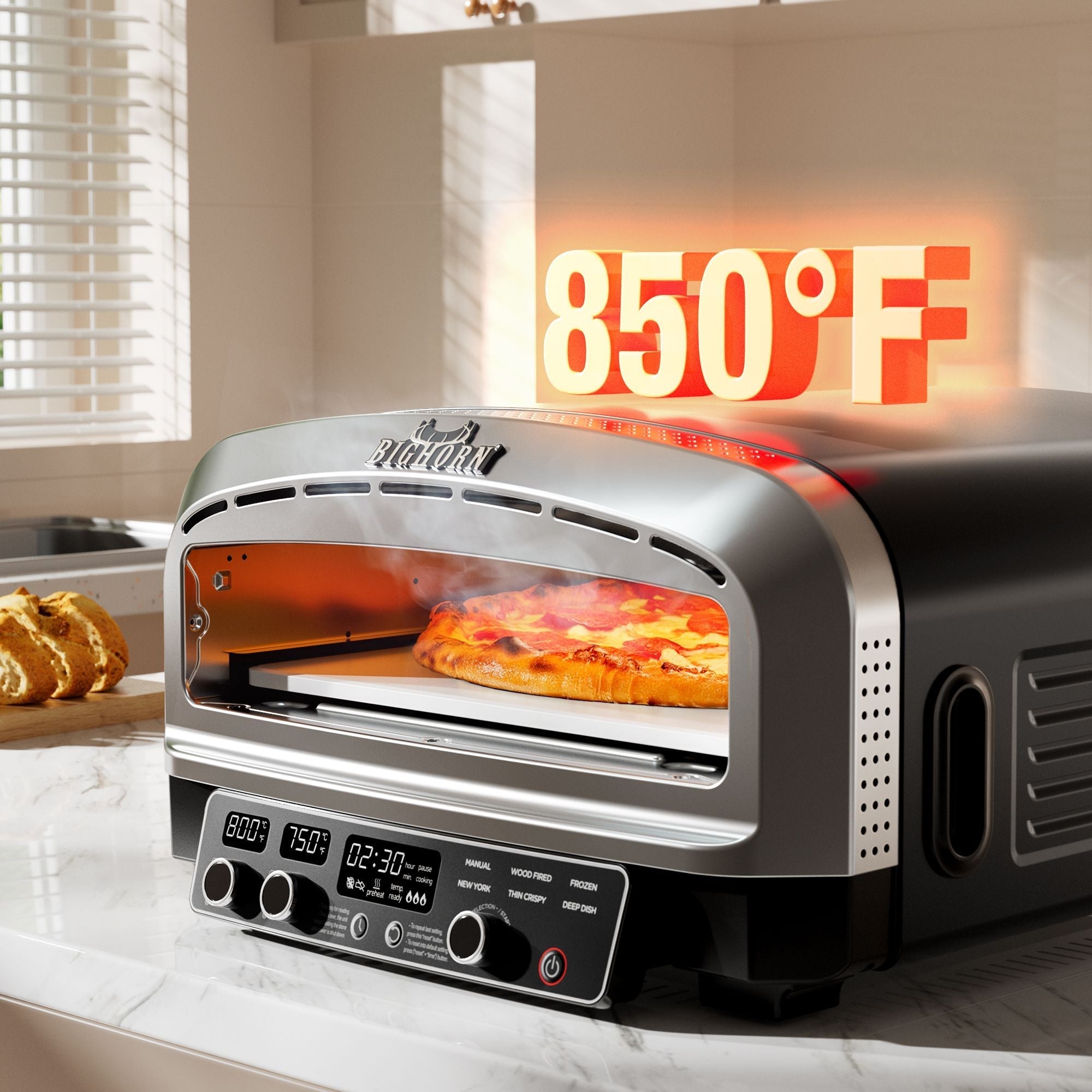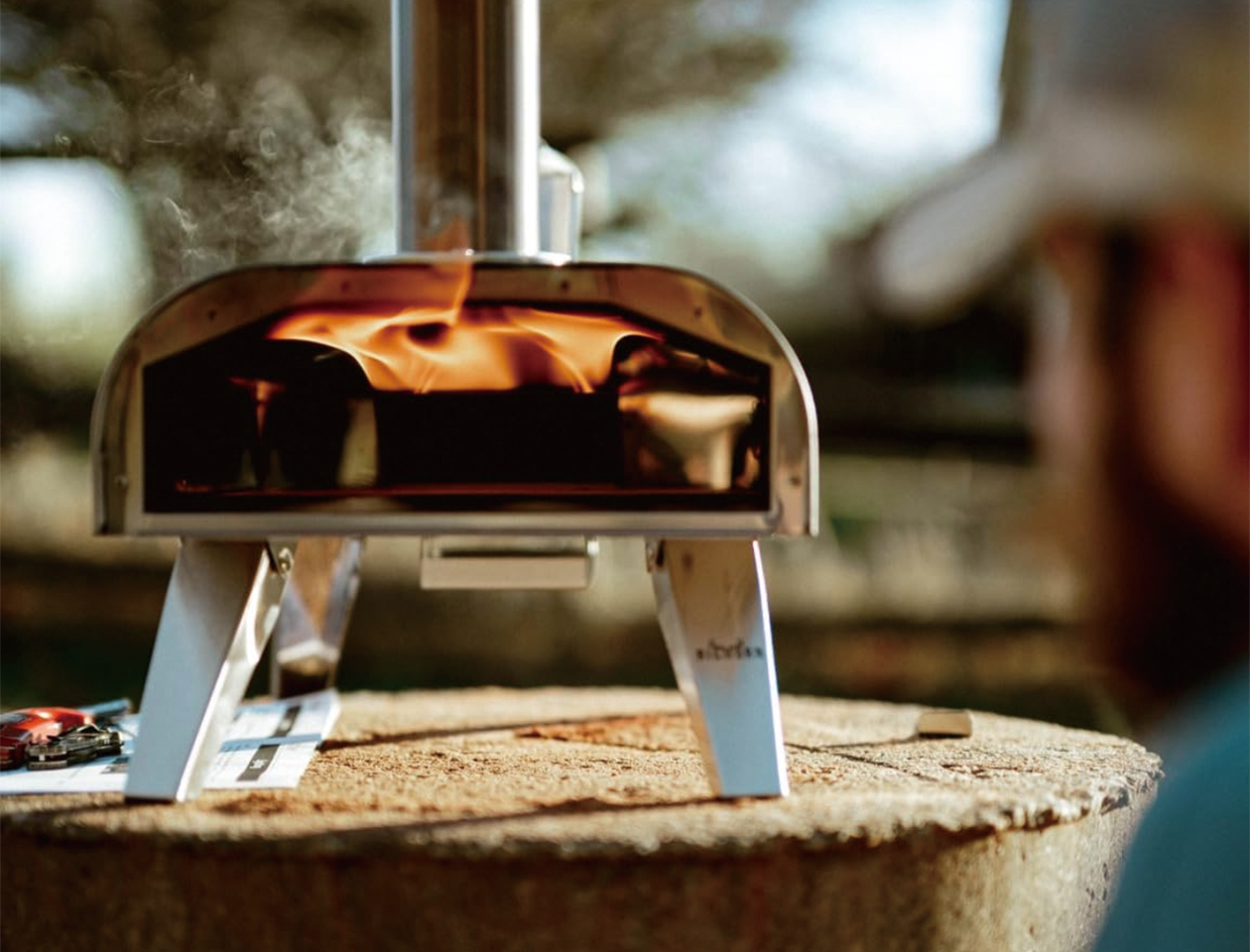Can your home oven really compete with a real pizza oven?
Your kitchen oven handles most cooking tasks well, using hot air that takes time to cook food. A pizza oven works completely differently - it surrounds your pizza with blazing heat from all sides and cooks it in seconds. But does faster always mean better?
Each oven has its fans. Pizza oven lovers swear by that crispy-yet-chewy crust and lightning-fast cooking. Regular oven users point to convenience, cost, and versatility. So which side is right?
Let's put both ovens head-to-head. We'll compare them on heat levels, pizza results, ease of use, and cost to see which one comes out on top for your pizza needs.
A Quick Overview: The Two Options
Let's look at what we're comparing: the pizza specialist and the kitchen all-star.
The Pizza Oven: Built for One Thing
Pizza ovens work just like those brick ovens at your favorite pizzeria. They can make amazing pizza with super-high heat.
The key is the dome shape. It traps heat from the fire and bounces it back down onto your pizza. The walls are made from brick, stone, or special steel that gets really hot and stays that way.
Your fuel options:
- Wood-Fired: Uses real wood for that classic smoky taste. Takes more work but gives authentic flavor.
- Gas: Hooks up to a propane tank. Start it with a button, control the heat easily.
- Multi-Fuel: Switch between wood (for flavor) and gas (for convenience).
- Electric: Easiest to use, can work indoors. Not quite as hot as the others.
Your Kitchen Oven: The Do-Everything Tool
Your regular oven handles everything—baking, roasting, broiling—at moderate temperatures. It heats the air in a big square box.
Want better pizza from your regular oven? Try these:
- Pizza Stone: A thick ceramic slab that gets hot and makes your crust crispier by pulling out moisture.
- Pizza Steel: A steel plate that heats up faster and hotter than stone. It gives your dough a better "puff-up" when it first hits the heat, getting you closer to real pizza oven results.
Fun fact: Steel only works well in home ovens. In a 900°F pizza oven, it would get too hot and burn your crust before the top cooked.
Round 1: Temperature & Heat Performance
Pizza ovens and kitchen ovens work at completely different heat levels. The temperature difference changes how pizza cooks.
Pizza Oven: Really Hot, Really Fast
Pizza ovens get much hotter than kitchen ovens. They reach 750°F to over 950°F.
Preheating is quick and simple: Gas pizza ovens heat up in 15-20 minutes. Wood-fired ovens take 20-30 minutes. You know the oven is ready when you can only hold your hand near the opening for 2-3 seconds. The stone floor gets hot enough to sear dough instantly.
Pizza ovens also deliver heat in three ways at the same time:
- Heat from the bottom: The hot stone floor cooks the bottom of the pizza right away.
- Heat from hot air: Super-hot air moves around inside the dome to cook the toppings and edges.
- Heat from above: The hot dome top sends heat down to cook the top of the pizza.
All three types working together cook a whole pizza very fast—often in 60 to 90 seconds. The dough puffs up quickly before it can dry out. This creates a light, airy inside with a crispy outside and those dark spots you see on good pizza.
What your pizza looks like: The crust puffs up dramatically with big air bubbles. The bottom gets crispy and spotted from the hot stone. The top develops those signature dark "leopard spots" from the intense heat above. Cheese melts perfectly without getting rubbery. Vegetables stay crisp and colorful.
Regular Oven: Not As Hot, Takes Much Longer
Your home oven reaches about 500°F to 550°F at most. It uses hot air to cook food inside a big box.
Preheating takes forever: Your oven says it's ready in 15 minutes, but that's just the air temperature. The pizza stone needs 45-60 minutes to get truly hot. Most people don't wait this long and end up with soggy pizza.
The lower heat requires much longer cook time—8 to 15 minutes or more. Water slowly leaves the dough during this longer bake, so it doesn't puff up much. The crust often comes out thicker and chewier, more like bread. You can make fewer pizzas since each one takes much longer.
What your pizza looks like: The crust stays flatter and denser, more like flatbread. The bottom might be pale or unevenly browned. No leopard spots on top—just even browning. Cheese can get greasy or rubbery from the long cooking time. Vegetables often dry out or get mushy.
Round 1 Winner: Pizza Oven
Pizza ovens completely dominate on temperature and heat performance. They reach 750-950°F while regular ovens max out at 550°F. They deliver heat three different ways at once, creating that perfect pizza environment. Regular ovens only use hot air. The temperature difference means pizza ovens cook in 60-90 seconds versus 8-15 minutes, and they create the light, airy crust with leopard spots that regular ovens simply can't match.
Round 2: Cooking Results & Pizza Quality
The heat differences create very different pizzas. Here's how each oven performs.
Pizza Oven: Restaurant-Quality Results
- The Crust: Pizza ovens create the puffy outer edge that real pizzerias make. The fast, intense heat fills the crust with big air pockets. You get a crisp outside and soft, chewy inside. The bottom cooks perfectly with a little char that adds flavor. This is the only way to make true Italian-style pizza at home.
- The Toppings: The 60-second cook time changes everything for toppings. Vegetables get nicely charred but stay crisp and fresh. Cheese melts perfectly without getting oily. Fresh herbs like basil cook lightly instead of burning.
- The Flavor: Wood-fired pizza ovens add flavor you can't get anywhere else. The burning wood gives pizza a light, smoky taste that makes it taste like traditional pizzeria pizza.
- What you get: Pizza that looks and tastes like it came from a real pizzeria. Light, airy crust with dark spots. Perfect cheese. Vegetables that stay colorful and crisp.
Regular Oven: Good Home-Style Pizza
- The Crust: Even with a pizza steel, regular ovens make more evenly browned crust. It can be crispy and tasty, but it doesn't have the big, airy puff and dark spots of pizza oven pizza. The browning is golden-brown all over.
- The Toppings: The longer cooking time creates problems. Watery toppings like fresh mushrooms or tomatoes release steam and make the pizza soggy in the middle. By the time the crust finishes, other toppings can get dry or overcooked.
- The Flavor: The flavor tastes like baked bread and cooked toppings. It's satisfying, but it lacks that special, smoky character that makes wood-fired pizza so memorable.
- What you get: Pizza that tastes good but different from pizzeria pizza. Denser crust. Toppings that can get soggy or dried out. Standard baked flavor.
Round 2 Winner: Pizza Oven
Pizza ovens win easily on pizza quality. They create the light, airy crust with perfect char that defines great pizza. The fast cooking keeps toppings fresh and prevents sogginess. Wood-fired models add authentic smoky flavor. Regular ovens make decent pizza, but they can't match the texture, appearance, or flavor of pizza oven results.
Round 3: Convenience & Ease of Use
Besides pizza quality, how you use each oven day-to-day matters a lot.
Pizza Oven: Fast Cooking, More Setup
- Speed: Once hot, you can cook a pizza every 90 seconds. Perfect for feeding groups quickly.
- Gas models are simple: Turn a knob to light the flame and set temperature. Works like a gas grill.
- Wood models take practice: You need to learn fire management. Building and keeping a steady fire takes time to master. Some people love this process, others find it frustrating.
- Space requirements: Most pizza ovens go outdoors only. They need at least three feet of clear space around them for safety.
- Fuel planning: You must keep propane tanks full or stock dry hardwood. Running out of fuel mid-cooking ruins the meal.
- Social cooking: Outdoor pizza ovens turn cooking into a gathering spot. People naturally hang around and watch.
- Cleanup varies: Gas models clean easily. Wood ovens leave ash you must remove after they cool completely.
Regular Oven: Always Ready, Always Slow
- Zero setup: Already in your kitchen and ready to use. No fuel to buy, no weather concerns.
- Familiar controls: You already know how to use it. No learning curve.
- Works for everything: Your oven handles countless other meals. Pizza is just one of many uses.
- Slow for groups: Cooking multiple pizzas takes forever. The first person finishes eating before the last pizza comes out.
- Accessory hassle: Pizza stones or steels must preheat 30-60 minutes. Handling 500°F slabs of stone or steel requires care.
- Heat loss problems: Opening the big door lets lots of heat escape. This slows cooking and wastes energy.
- Indoor heat: Running at maximum temperature heats up your whole kitchen, especially in summer.
Round 3 Winner: Depends on Your Priorities
Pizza ovens win for: Speed once running, social cooking, feeding groups quickly.
Regular ovens win for: Simplicity, no setup, year-round indoor use, versatility.
The winner depends on what matters more to you—convenience of setup or convenience of cooking speed.
Round 4: Cost & Investment
Money matters when choosing between these ovens. Here's what each option costs.
Pizza Oven: New Purchase Required
- Initial cost: Prices vary widely. At Big Horn Outdoors, our portable models start around $100, super affordable and good to use. Higher-priced Big Horn models can range up to around $400, while high-end ovens from various brands may cost $800 to $2,000, or more.
- Extra gear needed: The oven is just the start. You need a pizza peel to slide pizzas in and out, a pizza stone for optimal cooking, and a cover. These accessories add another $100 or more to your startup costs.
- Fuel costs: You keep buying fuel forever. Propane tank refills, hardwood bags, charcoal, or wood pellets all cost money each time you cook.
- Long-term value: Families who order pizzeria pizza often might save money over time if you buy an expensive pizza oven. A $1,500 pizza oven setup could pay for itself in 1-2 years by replacing restaurant orders.
Regular Oven: Use What You Have
- Initial cost: Basically free. You already own an oven.
- Accessory costs: The main purchase is a cooking surface. Quality pizza stones cost $30 to $50. Better pizza steels run $60 to $130. A pizza peel helps too but costs under $30.
- Ongoing costs: Very little. Just the small amount of electricity or gas your oven uses, which is already part of your monthly utility bill.
- No fuel needed: Unlike pizza ovens, you don't buy special fuel. Your regular energy bill covers everything.
Round 4 Winner: Regular Oven
Regular ovens win on cost. You can start making better pizza for under $100 in accessories versus $200+ for a basic pizza oven setup. Ongoing costs are minimal since you already pay for utilities. Pizza ovens only make financial sense if you cook pizza very frequently or want to replace expensive restaurant orders.
Which is Better FOR YOU? Making Your Decision
After four rounds of comparison, both ovens have clear strengths. The right choice depends on your specific situation and priorities.
Choose a Pizza Oven If:
You're serious about pizza quality.
Pizza ovens create restaurant-level results that regular ovens simply can't match. The light, airy crust with leopard spots and perfect toppings are worth the investment if great pizza matters to you.
You love outdoor cooking and entertaining.
Pizza ovens turn cooking into a social event. Guests gather around, kids get excited, and making pizza becomes part of the fun, not just the meal.
You cook pizza frequently.
If you make pizza weekly or host pizza parties regularly, the speed and quality make sense. You can feed a crowd in minutes instead of hours.
You have outdoor space.
Most pizza ovens need a safe outdoor spot with proper clearance. If you have a patio, deck, or yard, this isn't a problem.
Budget allows for the investment.
Starting costs of $100+ for basic models plus accessories mean you need to be comfortable with the upfront expense.
Stick with Your Regular Oven If:
You want simple, no-fuss cooking.
Your kitchen oven is always ready, needs no setup, and works in any weather. Just add a pizza stone for better results.
You make pizza occasionally.
For monthly pizza nights or casual cooking, your regular oven with a good stone or steel produces satisfying results.
Budget is tight.
Under $100 in accessories can significantly improve your home pizza without breaking the bank.
You live in an apartment or have space limits.
Indoor ovens work anywhere. No outdoor space required, no neighbor considerations.
You value versatility.
Your regular oven handles everything from birthday cakes to Sunday roasts. It's a true multi-purpose tool.
The Bottom Line
For authentic, pizzeria-quality results: Pizza oven wins every time.
For practical, everyday cooking: Regular oven is hard to beat.
For the best of both worlds: Start with a pizza stone in your regular oven. If you fall in love with pizza making and want better results, then consider upgrading to a dedicated pizza oven.
The "better" choice depends on which oven fits your cooking style, space, budget, and pizza goals. Both can make delicious pizza. The question is what kind of pizza experience you want.
Ready to take your pizza to the next level? At Big Horn Outdoors, we offer high-quality pizza ovens designed for backyard chefs who want authentic results. From portable gas models to traditional wood-fired ovens, we have options for every space and budget. Visit bighornoutdoors.com and start making pizzeria-quality pizza at home tonight.




